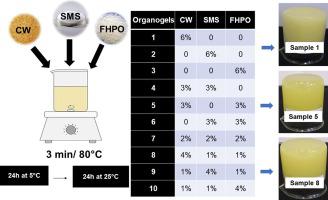Food Research International ( IF 7.0 ) Pub Date : 2020-06-20 , DOI: 10.1016/j.foodres.2020.109460 Kamila Ramponi Rodrigues de Godoi , Rodrigo Correa Basso , Chiu Chih Ming , Alan Ávila da Silva , Lisandro Pavie Cardoso , Ana Paula Badan Ribeiro

|
Organogels are semi-solid systems where the liquid phase is immobilized for three-dimensional network self-sustained formed by structuring agents capable to hold a larger quantity of liquid oil. The use of these structuring agents or crystallization modifiers, as specific triacylglycerols, emulsifiers and high molecular weight - high melting point lipids, have been recognized as the main alternative for obtaining low saturated fats for food formulation. The aim of this work was to evaluate the crystallization, microstructure and polymorphism properties of hybrid soybean oil (SO) organogels, formulated with 6% (w:w) of structuring agents through a centroid simplex system added singly, in binary or ternary association of candelilla wax (CW), sorbitan monostearate (SMS) and fully hydrogenated palm oil (FHPO). The thermal behavior, crystallization kinetics, physical stability by temperature cyclization, microstructure and polymorphism were evaluated. FHPO and CW increased the stability and ability to form crystalline networks in organogels, while SMS accelerated the crystallization process. The structuring agents increased the initial and final crystallization temperatures, even as the melting temperatures and the enthalpy values of organogels. Time-temperature cyclization (cyclization 1: 5 °C/48 h + 35 °C/24 h + 5 °C/24 h; cyclization 2: 35 °C/48 h + 5 °C/72 h) showed that all the systems resulted in firm and stable organogels, except when SMS or FHPO were used singly. CW promoted formation of denser crystalline networks with higher solids content, quick crystallization onset and higher melting points that indicates adequate thermal resistance; while FHPO increased the solid content although it was effective to obtain organogels only at the cooling temperature (5 °C). The binary interaction of FHPO + CW increased the thermal resistance of organogels; and the interactions among SMS + CW and SMS + CW + FHPO although it was effective to obtain organogels. Regardless of the presence and proportions of structuring agents, organogels were characterized by beta polymorphism.
中文翻译:

杂化结构体系中豆油有机凝胶的结晶,微观结构和多晶型性质
有机胶是半固态系统,其中液相固定化用于三维网络自我维持,该三维网络由能够容纳大量液态油的结构剂形成。这些结构剂或结晶改性剂的使用,作为特定的三酰基甘油,乳化剂和高分子量-高熔点脂质,已被公认为是获得低饱和脂肪的食品配方的主要替代方法。这项工作的目的是评估杂化大豆油(SO)有机凝胶的结晶,微观结构和多态性,杂化大豆油(SO)有机凝胶由6%(w:w)的结构剂通过单独添加的质心单纯形体系以二元或三元缔合形式配制。小烛树蜡(CW),脱水山梨糖醇单硬脂酸酯(SMS)和完全氢化的棕榈油(FHPO)。热行为 评价了结晶动力学,温度环化的物理稳定性,微观结构和多态性。FHPO和CW增加了在有机凝胶中形成晶体网络的稳定性和能力,而SMS则加快了结晶过程。结构化剂提高了初始和最终结晶温度,甚至提高了有机凝胶的熔融温度和焓值。时间-温度环化(环化1:5°C / 48 h + 35°C / 24 h + 5°C / 24 h;环化2:35°C / 48 h + 5°C / 72 h)显示所有除了单独使用SMS或FHPO之外,该系统可产生牢固而稳定的有机凝胶。连续波促进了具有更高固含量,更快结晶开始和更高熔点的致密晶体网络的形成,这表明有足够的耐热性;尽管FHPO仅在冷却温度(5°C)下有效获得有机凝胶,但增加了固含量。FHPO + CW的二元相互作用增加了有机凝胶的耐热性;以及SMS + CW和SMS + CW + FHPO之间的相互作用,尽管可以有效地获得有机凝胶。无论结构剂的存在和比例如何,有机凝胶均以β多态性为特征。











































 京公网安备 11010802027423号
京公网安备 11010802027423号